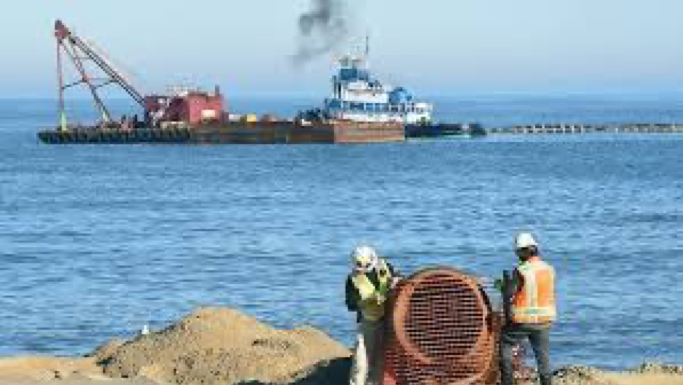DREDGING IMPACT OF BEACH REPLENISHMENT
Pumping sand onto our beaches has negative impacts at both ends – where the sand is put and where it is dredged from. But don’t take our word for it.
The Atlantic States Marine Fisheries Commission (ASMFC) produced a report titled, “Beach Nourishment: A Review of the Biological and Physical Impacts.” They found plenty worth concern.
The first negative is the impact on organisms living on the seabed. As described in the report, “Dredging involves the complete removal of sediment, which leads to direct mortality to the benthic infauna that live in the substrate.” This is hardly surprising, and the areas impacted are not small. According to the Army Corps of Engineers, to supply sand for just one small portion of their work in New Jersey, the Elberon to Loch Arbour stretch, 4,450,000 cubic yards of material would be dredged from the Sea Bright Borrow Area, a 3-square mile tract off the southern end of Sandy Hook. And that is only the sand taken from that area in the first cycle. The work is repeated 5x for a grand total of 8,750,000 cubic yards of sand. That’s enough material to dig out approx. 1,400 football fields waist deep, or fill a dump truck more than 70,000 times.

The ASMFC report states, “The mine site usually fills in to some degree, although filling may take years and be incomplete (often leaving a pit). The material filling the pit may be similar to the mined material or quite different in grain size.” Is that a problem? Yes. The material dredged for placement on the beach must be carefully matched to the original material or environmental damage is heightened. If the mine pit fills with sediment that is, “quite different in grain size” between one mining operation and the next, the replenished site will get a nasty jolt when this dissimilar material is dug up and used.
Another problem is the long-term nature of New Jersey projects, where beaches are replenished continuously over decades. The mined areas may only have a few years to recover and, according to the AMFSC report, that probably isn’t enough. The report found, “…recovery rates ranging from 1.75 years at a relatively small site to 11.8 years at one of the larger sites. The average recovery among all five sites was 6.8 years.”
The AMFSC report also states, “Mined areas can also refill with decomposed organic matter that is silty and anaerobic, hydrogen sulfide levels may increase, and eventually, the area may become anoxic [devoid of oxygen]. Such areas may never recover from these dredging events.”
This may be happening right now at dredged sites along the New Jersey coast, but how can we know? Analysis of the mined sites was done before the projects began. Down the road, that detailed analysis is not repeated.
How fast marine life recolonizes mined sites on the seabed is open to debate. We certainly expect that in cases where anoxic conditions are created, no recovery is possible. Even reports quoted by the Army Corps to justify their projects note that, “…recovery times of up to three years were need to restore functional groups such as deposit feeders and mid-depth burrowers.” They reported that recovery of the abundance of organisms in one New Jersey study took up to 2.5 years. We must combine this slow rate with overlapping projects drawing material from the same area. For example, the Monmouth Beach replenishment in 2012, Sea Bright to Monmouth in 2013, Long Branch in 2014 and Elberon to Deal in 2016, all took their sand from the Sea Bright Borrow Area. Even with a rapid 3-year recovery, there is substantial degradation on the ocean floor for at least 8 years.
Overall, the impact on ocean fisheries is not well known. The Army Corps reports that 58 species of fish were identified in the Sea Bright Borrow Area. Their report concluded, “No direct or indirect impacts to fish within the delineated project…are anticipated.” Yet, the AMSFC report is less certain. It says, “The degree to which fish are impacted by changes in habitat needs to be assessed. Species that are truly dependent on the affected habitat and those that are unable to avoid entrainment should be identified. Additionally, conceptual food web models should be developed so that researchers can gain a better understanding of the impacts that may occur throughout the food chain.” When discussing fish, we are more inclined to trust the word of a Fisheries Commission than a group of engineers justifying their project.
In summary, there is a great deal that remains unknown about the degradation caused by sand dredging on marine ecosystems. What we do know is troubling enough. Have we rushed in blindly with insufficient data? Ignored important points? Failed to repeat needed analysis? Probably. Another good reason not to double the potential damage.
References:
1 – Greene, K. (November 2002) “Beach Nourishment: A Review of the Biological and Physical Impacts”. Atlantic States Marine Fisheries Commission. Retrieved August 18, 2021, from http://www.asmfc.org/uploads/file/beachNourishment.pdf
2 – United States Army Corps of Engineers, NY District. (February 2014). “Atlantic Coast of New Jersey Sandy Hook to Barnegat Inlet Beach Erosion Control Project, Section 1 – Sea Bright to Ocean Township: Elberon to Loch Arbour Reach Draft Integrated Hurricane Sandy Limited Reevaluation Report and Environmental Assessment”. United States Army Corps of Engineers NY District Website. Retrieved August 18, 2021, from https://www.nan.usace.army.mil/Portals/37/docs/civilworks/projects/nj/coast/SHtoBI/EtoLA/Main_Rpt_21_Feb_2014.pdf
3 – Wilber, D., Clarke, D. (2007). “Defining and Assessing Benthic Recovery Following Dredging and Dredged Material Disposal”. Western Dredging Association. Retrieved August 18, 2021, from https://www.westerndredging.org/
4 – United States Army Corps of Engineers, NY District. (February 2014). “Atlantic Coast of New Jersey Sandy Hook to Barnegat Inlet Beach Erosion Control Project, Section 1 – Sea Bright to Ocean Township: Elberon to Loch Arbour Reach Draft Integrated Hurricane Sandy Limited Reevaluation Report and Environmental Assessment”. United States Army Corps of Engineers NY District Website. Retrieved August 18, 2021, from https://www.nan.usace.army.mil/Portals/37/docs/civilworks/projects/nj/coast/SHtoBI/EtoLA/Main_Rpt_21_Feb_2014.pdf
